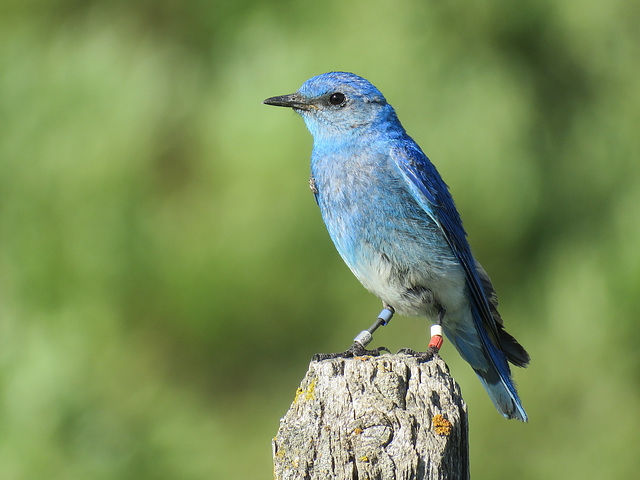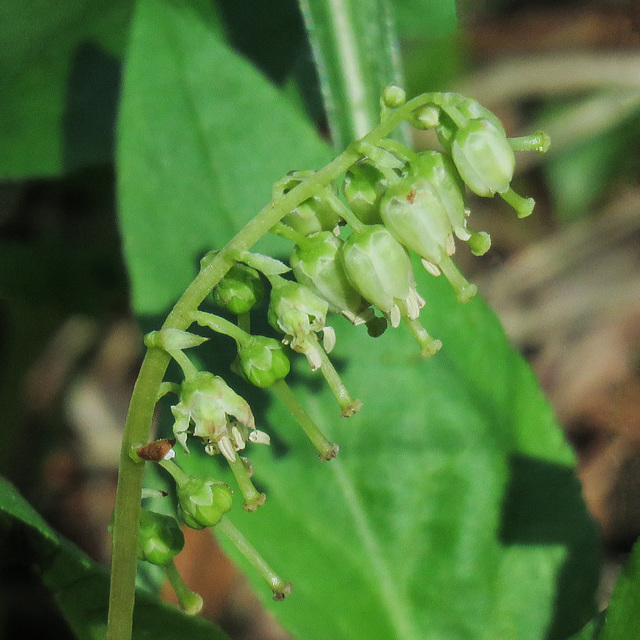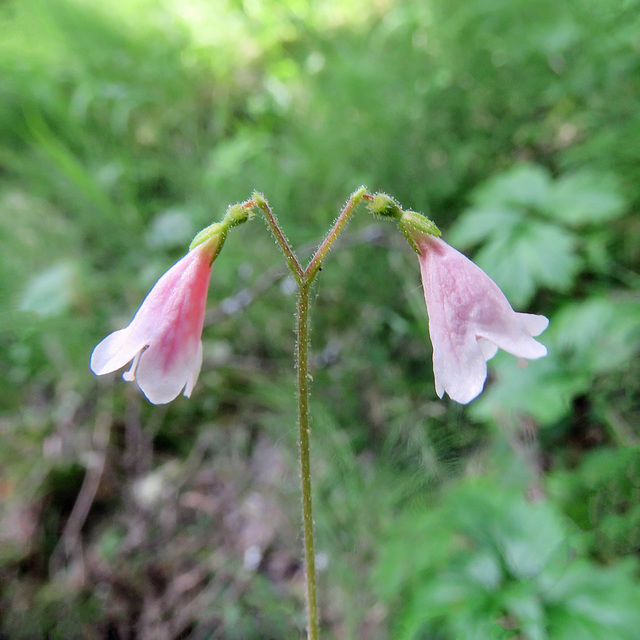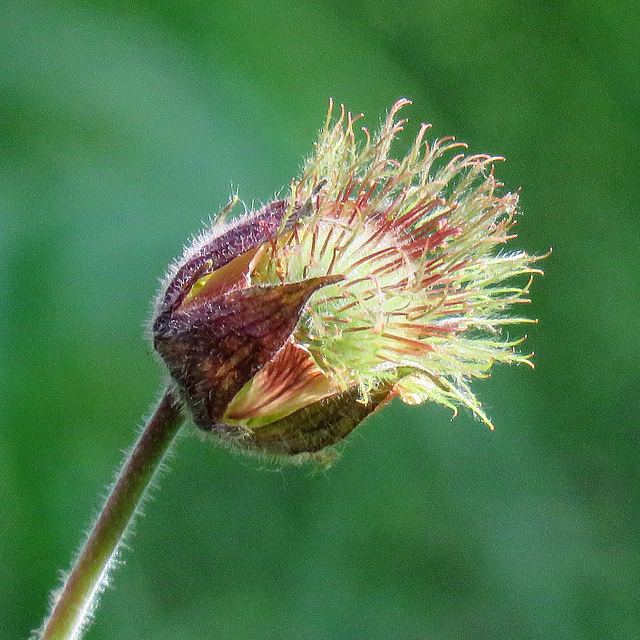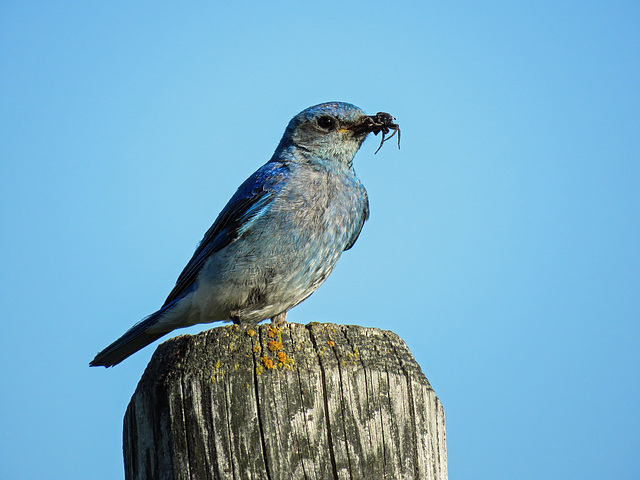
Canon SX60
13 Jul 2018
2 favorites
2 comments
Tiny spider with a death wish
Yesterday afternoon, 13 July 2018, I watched as a tiny spider crawled up the breast of this motionless male Mountain Bluebird - and suddenly, goodbye spider!
How wonderful it feels to have a cooler morning! A short while ago, it was just 11C, now 15C just before noon. Finally, I can get some cooler air inside my place. The last two days, I have had to go out in my car just to get the relief of air-conditioning. Yesterday, I more or less repeated my drive from the previous day, except that I called in at Brown-Lowery Provincial Park to see if there was any sign of fungi growing. It is still not the peak of the fungi season, so I was not too hopeful. I barely entered the forest, as it still gives me the creeps, - Bears, Cougar and Moose are seen there, and I have been told so many times not to go by myself. So far, I have only seen a very large Moose. I did find a cluster of very tiny mushrooms ad several clumps of orange Coral Fungus in their usual location. Took a few wildflower shots, too, which I don't do very often these days, unlike a few years ago.
In Bluebirds, the blue colour is produced by the structure of the feather - there is no blue pigment. "Tiny air pockets in the barbs of feathers can scatter incoming light, resulting in a specific, non-iridescent color. Blue colors in feathers are almost always produced in this manner. Examples include the blue feathers of Bluebirds, Indigo Buntings, Blue Jay's and Steller's Jays."
www.allaboutbirds.org/guide/Mountain_Bluebird/id
www.jstor.org/discover/pgs/index?id=10.2307/4077277&i...
"A female Mountain Bluebird pays more attention to good nest sites than to attractive males. She chooses her mate solely on the basis of the location and quality of the nesting cavity he offers her—disregarding his attributes as a singer, a flier, or a looker.
A male Mountain Bluebird frequently feeds his mate while she is incubating and brooding. As the male approaches with food, the female may beg fledgling-style—with open beak, quivering wings, and begging calls. More often, she waits until her mate perches nearby, then silently flicks the wing farthest from him—a signal that usually sends him off to find her a snack.
The oldest recorded Mountain Bluebird was a female, and at least 9 years old when she was recaptured and rereleased during banding operations in Alberta in 2005. She had been banded in the same province in 1997." From AllAboutBirds.
www.allaboutbirds.org/guide/Mountain_Bluebird/
13 Jul 2018
One-sided Wintergreen / Orthilia secunda
Yesterday evening, I finally got round to backing up all the photo files (626 GB) on my hard drive to another, larger external hard drive. After a few hours, I checked to see how it had done and discovered that only maybe half the photos had been copied. So, I started a second copy, hoping that this time, all the files would be successfully copied. This morning, I found that it was successful. So, I decided to delete the first copy, forgetting that the second copy was actually downloaded within the first copy. So another nine hours wasted! Tonight, I will have to start all over again, and then I need to do the same with a second, larger hard drive. I am almost out of room on my computer hard drive and need to start deleting a lot of my oldest images, or I will not be able to download new photos to it, and I will start to have a lot of problems. Yes, I would much rather be out on a nice drive : )
On this day, 13 July 2018, I more or less repeated my drive SW of the city, from two days earlier, except that I called in at Brown-Lowery Provincial Park to see if there was any sign of fungi growing. It is still not the peak of the fungi season, so I was not too hopeful. I barely entered the forest, as it still gives me the creeps, - Bears, Cougar and Moose are seen there, and I have been told so many times not to go by myself. So far, I have only seen a very large Moose. I did find a cluster of very tiny mushrooms ad several clumps of orange Coral Fungus in their usual location. Took a few wildflower shots, too, which I don't do very often these days, unlike a few years ago.
13 Jul 2018
One-flowered Wintergreen / Moneses uniflora
When I took this photo, I did something that I haven't done for a long, long time! I actually got down on my hands and knees, but only because I was in a secluded spot where I could be sure nobody was likely to witness my getting up : ) And I was on my own. I find this flower difficult to photograph, whether from a distance or close up. I have just started taking a few macro shots with my old Canon SX60, so tried to use it for this flower. Often, in order to see the underneath parts, the flower needs to be tipped upwards. If that is done, it must be done very gently using a tiny twig or leaf, not with ones fingers, as the oil in the skin can kill plants or attract insects or animals that eat the flowers. The light in the forest was not good and I ended up with grainy photos that are not sharp. Such a fascinating flower, which is also known as One-flowered Pyrola.
On this day, 13 July 2018, I more or less repeated my drive from the previous day, except that I also called in at Brown-Lowery Provincial Park to see if there was any sign of fungi growing. It is still not the peak of the fungi season, so I was not too hopeful. I barely entered the forest, as it still gives me the creeps, - Bears, Cougar and Moose are seen there, and I have been told so many times not to go by myself. So far, I have only seen a very large Moose. I did find a cluster of very tiny mushrooms and several clumps of orange Coral Fungus in their usual location. Took a few wildflower shots, too, which I don't do very often these days, unlike a few years ago.
13 Jul 2018
Twinflower / Linnaea borealis
Yesterday evening, I finally got round to backing up all the photo files (626 GB) on my hard drive to another, larger external hard drive. After a few hours, I checked to see how it had done and discovered that only maybe half the photos had been copied. So, I started a second copy, hoping that this time, all the files would be successfully copied. This morning, I found that it was successful. So, I decided to delete the first copy, forgetting that the second copy was actually downloaded within the first copy. So another nine hours wasted! Tonight, I will have to start all over again, and then I need to do the same with a second, larger hard drive. I am almost out of room on my computer hard drive and need to start deleting a lot of my oldest images, or I will not be able to download new photos to it, and I will start to have a lot of problems. I don't use my computer while the back-up is in process, which is a bit frustrating. Yes, I would much rather be out on a nice drive : )
On 13 July 2018, I more or less repeated my drive from two days earlier, except that I also called in at Brown-Lowery Provincial Park to see if there was any sign of fungi growing. It is still not the peak of the fungi season, so I was not too hopeful. I barely entered the forest, as it still gives me the creeps, - Bears, Cougar and Moose are seen there, and I have been told so many times not to go by myself. So far, I have only seen a very large Moose. I did find a cluster of very tiny mushrooms and several clumps of orange Coral Fungus in their usual location. Took a few wildflower shots, too, which I don't do very often these days, unlike a few years ago.
"Linnaea is named after Carolus Linnaeus 1707-78), the ‘father of botany’, who established the classfication system of plants and animals which assigns each organism a two word name (genus and species). Borealis is named for the Greek god of the north wind, Boreas, which means ‘northern’.
The flowers are small (6 mm to 15 mm long), pinkish white, bell-shaped, and are fragrant, especially towards evening. Flowers occur in pairs on V-shaped stalks." From link below.
plantwatch.naturealberta.ca/choose-your-plants/twinflower/
13 Jul 2018
Mountain Bluebird male
Yesterday evening, I finally got round to backing up all the photo files (626 GB) on my hard drive to another, larger external hard drive. After a few hours, I checked to see how it had done and discovered that only maybe half the photos had been copied. So, I started a second copy, hoping that this time, all the files would be successfully copied. This morning, I found that it was successful. So, I decided to delete the first copy, forgetting that the second copy was actually downloaded within the first copy. So another nine hours wasted! Tonight, I will have to start all over again, and then I need to do the same with a second, larger hard drive. I am almost out of room on my computer hard drive and need to start deleting a lot of my oldest images, or I will not be able to download new photos to it, and I will start to have a lot of problems. I don't use my computer while the back-up is in process, which is a bit frustrating. Yes, I would much rather be out on a nice drive : )
On 13 July 2018, I more or less repeated my drive from two days earlier, except that I also called in at Brown-Lowery Provincial Park to see if there was any sign of fungi growing. It is still not the peak of the fungi season, so I was not too hopeful. I barely entered the forest, as it still gives me the creeps, - Bears, Cougar and Moose are seen there, and I have been told so many times not to go by myself. So far, I have only seen a very large Moose. I did find a cluster of very tiny mushrooms and several clumps of orange Coral Fungus in their usual location. Took a few wildflower shots, too, which I don't do very often these days, unlike a few years ago.
In Bluebirds, the blue colour is produced by the structure of the feather - there is no blue pigment. "Tiny air pockets in the barbs of feathers can scatter incoming light, resulting in a specific, non-iridescent color. Blue colors in feathers are almost always produced in this manner. Examples include the blue feathers of Bluebirds, Indigo Buntings, Blue Jay's and Steller's Jays."
www.allaboutbirds.org/guide/Mountain_Bluebird/id
www.jstor.org/discover/pgs/index?id=10.2307/4077277&i...
"A female Mountain Bluebird pays more attention to good nest sites than to attractive males. She chooses her mate solely on the basis of the location and quality of the nesting cavity he offers her—disregarding his attributes as a singer, a flier, or a looker.
A male Mountain Bluebird frequently feeds his mate while she is incubating and brooding. As the male approaches with food, the female may beg fledgling-style—with open beak, quivering wings, and begging calls. More often, she waits until her mate perches nearby, then silently flicks the wing farthest from him—a signal that usually sends him off to find her a snack.
The oldest recorded Mountain Bluebird was a female, and at least 9 years old when she was recaptured and rereleased during banding operations in Alberta in 2005. She had been banded in the same province in 1997." From AllAboutBirds.
www.allaboutbirds.org/guide/Mountain_Bluebird/
13 Jul 2018
One-flowered Wintergreen, with texture
Yesterday evening, I finally got round to backing up all the photo files (626 GB) on my hard drive to another, larger external hard drive. After a few hours, I checked to see how it had done and discovered that only maybe half the photos had been copied. So, I started a second copy, hoping that this time, all the files would be successfully copied. This morning, I found that it was successful. So, I decided to delete the first copy, forgetting that the second copy was actually downloaded within the first copy. So another nine hours wasted! Tonight, I will have to start all over again, and then I need to do the same with a second, larger hard drive. I am almost out of room on my computer hard drive and need to start deleting a lot of my oldest images, or I will not be able to download new photos to it, and I will start to have a lot of problems. I don't use my computer while the back-up is in process, which is a bit frustrating. Yes, I would much rather be out on a nice drive : )
On 13 July 2018, I more or less repeated my drive from two days earlier, except that I also called in at Brown-Lowery Provincial Park to see if there was any sign of fungi growing. It is still not the peak of the fungi season, so I was not too hopeful. I barely entered the forest, as it still gives me the creeps, - Bears, Cougar and Moose are seen there, and I have been told so many times not to go by myself. So far, I have only seen a very large Moose. I did find a cluster of very tiny mushrooms and several clumps of orange Coral Fungus in their usual location. Took a few wildflower shots, too, which I don't do very often these days, unlike a few years ago. I don't often see this plant species - and it is quite easy to overlook.
When I took this photo, I did something that I haven't done for a long, long time! I actually got down on my hands and knees, but only because I was in a secluded spot where I could be sure nobody was likely to witness my getting up : ) And I was on my own. I find this flower difficult to photograph, whether from a distance or close up. I have just started taking a few macro shots with my old Canon SX60, so tried to use it for this flower. Often, in order to see the underneath parts, the flower needs to be tipped upwards. If that is done, it must be done very gently using a tiny twig or leaf, not with ones fingers, as the oil in the skin can kill plants or attract insects or animals that eat the flowers. The light in the forest was not good and I ended up with grainy photos that are not sharp. Such a fascinating flower, which is also known as One-flowered Pyrola. I added a filter in post-processing to make the flower stand out a bit more.
13 Jul 2018
Purple Avens / Water Avens
Most people will probably be in bed by now, or at least not on Flickr, so I've just added 12 odds and ends of photos, taken on 13th July 2018. Though most of the flower photos leave a lot to be desired, I am using photos like these to try and re-teach myself about plant IDs. This evening, I was shocked that I had forgotten so many names. I knew the plants, but found it hard to remember the correct names. I've done so little botany for at least the last three years, which doesn't help. I'll be off my computer for quite a few hours while I back up all the photo files I have on my computer hard drive to two external hard drives that are larger than my present ones.
On 13 July 2018, I more or less repeated my drive from two days earlier, except that I also called in at Brown-Lowery Provincial Park to see if there was any sign of fungi growing. It is still not the peak of the fungi season, so I was not too hopeful. I barely entered the forest, as it still gives me the creeps, - Bears, Cougar and Moose are seen there, and I have been told so many times not to go by myself. So far, I have only seen a very large Moose. I did find a cluster of very tiny mushrooms and several clumps of orange Coral Fungus in their usual location. Took a few wildflower shots, too, which I don't do very often these days, unlike a few years ago.
This is another angle on Purple Avens that is going to seed. Quite a tall plant, and the flower and seedhead are rather unusual.
13 Jul 2018
Mountain Death Camas
Most people will probably be in bed by now, or at least not on Flickr, so I've just added 12 odds and ends of photos, taken on 13th July 2018. Though most of the flower photos leave a lot to be desired, I am using photos like these to try and re-teach myself about plant IDs. This evening, I was shocked that I had forgotten so many names. I knew the plants, but found it hard to remember the correct names. I've done so little botany for at least the last three years, which doesn't help. I'll be off my computer for quite a few hours while I back up all the photo files I have on my computer hard drive to two external hard drives that are larger than my present ones.
On 13 July 2018, I more or less repeated my drive from two days earlier, except that I also called in at Brown-Lowery Provincial Park to see if there was any sign of fungi growing. It is still not the peak of the fungi season, so I was not too hopeful. I barely entered the forest, as it still gives me the creeps, - Bears, Cougar and Moose are seen there, and I have been told so many times not to go by myself. So far, I have only seen a very large Moose. I did find a cluster of very tiny mushrooms and several clumps of orange Coral Fungus in their usual location. Took a few wildflower shots, too, which I don't do very often these days, unlike a few years ago.
I added a filter in post-processing to make the flower appear sharper. Love the ring of tiny green hearts (that are glands) in each flower.
13 Jul 2018
Mountain Bluebird male
Most people will probably be in bed by now, or at least not on Flickr, so I've just added 12 odds and ends of photos, taken on 13th July 2018. Though most of the flower photos leave a lot to be desired, I am using photos like these to try and re-teach myself about plant IDs. This evening, I was shocked that I had forgotten so many names. I knew the plants, but found it hard to remember the correct names. I've done so little botany for at least the last three years, which doesn't help. I'll be off my computer for quite a few hours while I back up all the photo files I have on my computer hard drive to two external hard drives that are larger than my present ones.
On 13 July 2018, I more or less repeated my drive from two days earlier, except that I also called in at Brown-Lowery Provincial Park to see if there was any sign of fungi growing. It is still not the peak of the fungi season, so I was not too hopeful. I barely entered the forest, as it still gives me the creeps, - Bears, Cougar and Moose are seen there, and I have been told so many times not to go by myself. So far, I have only seen a very large Moose. I did find a cluster of very tiny mushrooms and several clumps of orange Coral Fungus in their usual location. Took a few wildflower shots, too, which I don't do very often these days, unlike a few years ago.
In Bluebirds, the blue colour is produced by the structure of the feather - there is no blue pigment. "Tiny air pockets in the barbs of feathers can scatter incoming light, resulting in a specific, non-iridescent color. Blue colors in feathers are almost always produced in this manner. Examples include the blue feathers of Bluebirds, Indigo Buntings, Blue Jay's and Steller's Jays."
www.allaboutbirds.org/guide/Mountain_Bluebird/id
www.jstor.org/discover/pgs/index?id=10.2307/4077277&i...
"A female Mountain Bluebird pays more attention to good nest sites than to attractive males. She chooses her mate solely on the basis of the location and quality of the nesting cavity he offers her—disregarding his attributes as a singer, a flier, or a looker.
A male Mountain Bluebird frequently feeds his mate while she is incubating and brooding. As the male approaches with food, the female may beg fledgling-style—with open beak, quivering wings, and begging calls. More often, she waits until her mate perches nearby, then silently flicks the wing farthest from him—a signal that usually sends him off to find her a snack.
The oldest recorded Mountain Bluebird was a female, and at least 9 years old when she was recaptured and rereleased during banding operations in Alberta in 2005. She had been banded in the same province in 1997." From AllAboutBirds.
www.allaboutbirds.org/guide/Mountain_Bluebird/
Jump to top
RSS feed- Latest items - Subscribe to the latest items added to this album
- ipernity © 2007-2024
- Help & Contact
|
Club news
|
About ipernity
|
History |
ipernity Club & Prices |
Guide of good conduct
Donate | Group guidelines | Privacy policy | Terms of use | Statutes | In memoria -
Facebook
Twitter

